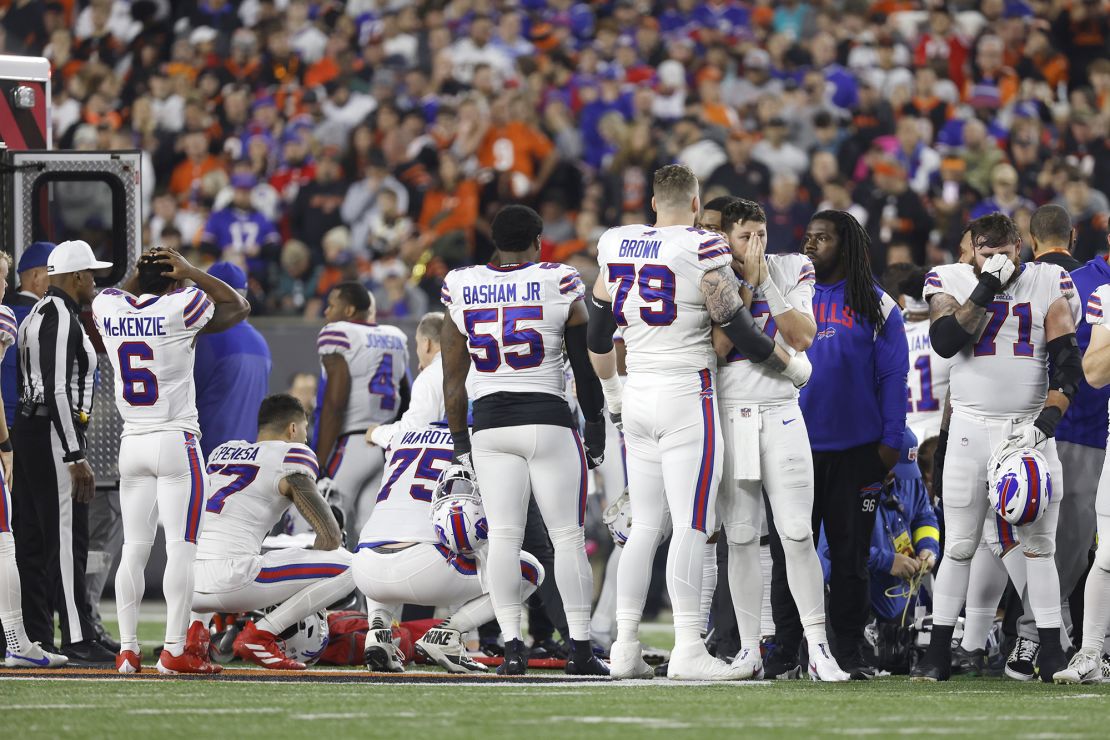Calling LeBron James, Tom Brady and Michelle Obama – Buffalo Bills star Damar Hamlin needs your help.
Hamlin launched a campaign on Tuesday, in partnership with the American Heart Association, to increase CPR awareness and education.
The 24-year-old, who received life-saving CPR on the field after suffering a cardiac arrest during a football game in January, announced the “3 For Heart CPR Challenge” in a video on his social media.
“As you know, CPR saved my life earlier this year on the field. And CPR could easily save your life or someone you love,” Hamlin said.
“That’s why I’m proud to announce that I’m partnering with the American Heart Association and kicking off Damar Hamlin’s Three for Heart CPR Challenge. And of course, this one has three steps.
“Step one, go to heart.org/3 to watch a short video to learn hands-only CPR. Step two, donate to the AHA to fund CPR awareness and education. And step three, challenge three friends to do the same.”
The Buffalo Bills safety launched the initiative by challenging two “GOATS” of US sports – NBA star LeBron James and NFL quarterback Tom Brady – as well as the former first lady Michelle Obama.
Hamlin spoke publicly on Saturday for the first time since he collapsed after making a tackle in the first quarter of the Bills-Bengals game on January 2.
Doctors and trainers gave Hamlin CPR on the field and he was rushed out of the stadium in an ambulance, leaving players, coaches, fans and those watching on TV in shock and unsure whether he was alive.

Medical officials said he suffered a cardiac arrest, meaning his heart abruptly stopped beating. The game was postponed and ultimately canceled.
Since then, Hamlin has made remarkable progress, and he was discharged from a Buffalo medical center on January 11.
Hamlin was present at the Bills’ divisional round match-up against the Cincinnati Bengals last Sunday, in which the Bills lost 27-10.
Before starting CPR, call 911 first
If you see someone with symptoms of cardiac arrest, call 911 immediately. You want to get professional help there as quickly as possible. When the heart can’t pump blood to the brain and the lungs, the person may become brain damaged or die within minutes.
If you’re in a public place, look for an automated external defibrillator, or AED.
These lightweight devices shock a person’s heart back into regular rhythm. An AED may look daunting, but it’s designed for use by anyone, even untrained bystanders.
When you press the power button, the device will give you step-by-step voice instructions on where to put the electrode pads on the person’s chest.
Once the pads are in place, the device measures the person’s heart rhythm. It won’t deliver a shock if the person doesn’t need one. But if they do, the AED will tell you to stand back and push a button to deliver the shock.
How to do CPR
After using the AED – or right away, if you don’t have access to one – start chest compressions.
Put your hands in the center of the person’s chest and press hard at 100 to 120 beats per minute. It may help to hum a song with this tempo such as “Stayin’ Alive” by the Bee Gees, Justin Timberlake’s “Can’t Stop the Feeling” or Lady Gaga’s “Just Dance.”
“You are literally acting like an external heart,” Dr. Comilla Sasson, a practicing emergency medicine physician and vice president for science and innovation for emergency cardiovascular care with the American Heart Association, previously told CNN.
It can get tiring, she said, so if someone else is nearby, have them take over when you need a break. If they don’t know CPR, have them watch you first. “That’s what we do in the emergency room,” Sasson said.
Get CNN Health's weekly newsletter
- Sign up here to get The Results Are In with Dr. Sanjay Gupta every Friday from the CNN Health team.
Locking your elbows gives you more leverage to push. With an adult, you’d typically use both hands for the chest compressions. But if you’re helping a baby, use one hand.
“Some people will ask me, ‘What if I do chest compressions and break a rib and hurt them?’ I tell them that this person is literally dead, and if they are fortunate to wake up because you did chest compressions, they’re going to be happy that you helped save their life. There’s a small number of people that get a broken rib,” Sasson said.






